7 MIN READ
Cotton Growth and Development
February 14, 2024
- Growth is an irreversible increase in size and mass.
- Development is the progression through defined phases.
- Cotton has a complex plant structure, which can make it a very challenging crop to manage.
- Cotton plants follow a set pattern of growth and development, according to accumulated heat units known as degree day 60s (DD60s). However, sensitivity to varying environmental conditions can also affect the plants’ development.
- Understanding cotton growth and development can help build a foundation for crop management.
Calculating Heat Units
Degree day 60s, or DD60s, are units of heat accumulation used in calculating the growth stage of cotton plants. Cotton growth and development progression can be characterized by the number of days since planting or emergence, but growth progression varies according to temperature. Monitoring cotton heat unit accumulation is useful for determining a more accurate estimation of a plant’s growth stage. Cotton plants have little to no development below 60 °F, so DD60s first average the difference in the daily maximum temperature and daily minimum temperature and then subtract 60 in order to calculate the daily accumulated DD60s, as represented in the formula: 1

Calculating the total accumulation of DD60s can help determine the growth stage of a cotton crop (Table 1). Online DD60 calculators may be available from your state extension. The number of DD60s required to achieve a growth stage will vary based on cotton variety. Earlier-maturing cotton varieties require fewer DD60s than later-maturing varieties to reach maturity.
Table 1. Estimated cotton growth stages from planting indicated by the accumulation of days and DD60s.

Emergence and Stand Establishment
Emergence typically occurs 4 to 9 days after planting, or after the accumulation of 50 DD60s.2 Seedling establishment is complete once the cotyledons emerge through the soil and unfold to expose the hypocotyl and apical meristem.
To help optimize cotton stand establishment, consider the following:
- Use a high-quality seed (standard warm germination test results of at least 80%).
- Plant when there is a favorable degree-day forecast for the five days post planting, with an expected heat unit accumulation of approximately 25 to 50 DD60s.
- The soil at planting depth should be warm and moist. By mid-morning, the soil temperature should be at least 68 °F at the desired planting depth for three consecutive days.3
- Seed should be planted 0.5 to 1.5 inches deep, depending on the soil texture and moisture. Shallow planting can result in poor seed-to-soil contact and deep planting can delay emergence and cause skippy stands. Confirm seed depth by digging up seeds after planting 50 to 100 ft of row.
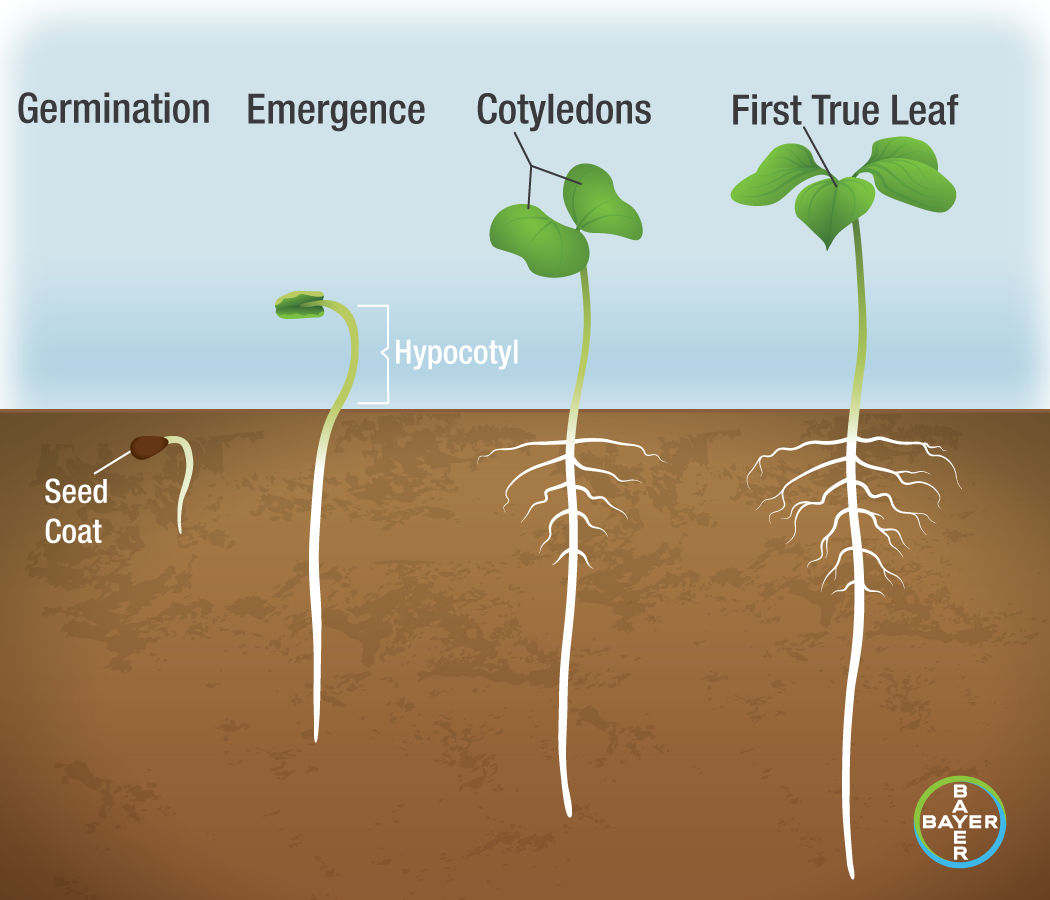
Early Vegetative Growth
Vegetative growth is categorized by the development of leaves, nodes, and roots. Cotton has an indeterminate growth habit, allowing plants to grow very tall and heavy with vegetation if they are not managed properly.
First true leaf. Emerges about 50 DD60s (or in four to nine days) after seedling establishment, shifting the plant’s energy source from cotyledons to the first emerging leaf.
Nodes. Points of attachment where leaves and branches form (Figure 2). A new node is produced by the apical meristem approximately every three days.
Leaves. Leaves produced from the main stem are called main-stem leaves and leaves located on fruiting branches are called subtending leaves (Figure 3). Main stem leaves are the first structures to appear on the main stem.
Roots. Cotton plants produce a taproot that can be 10 inches deep by the time the first true leaf is formed. Roots grow around 0.5 to 2 inches per day during early vegetative growth and slow substantially once bolls are set, as the plant directs carbohydrates away from root development to boll development.4
Branch Development
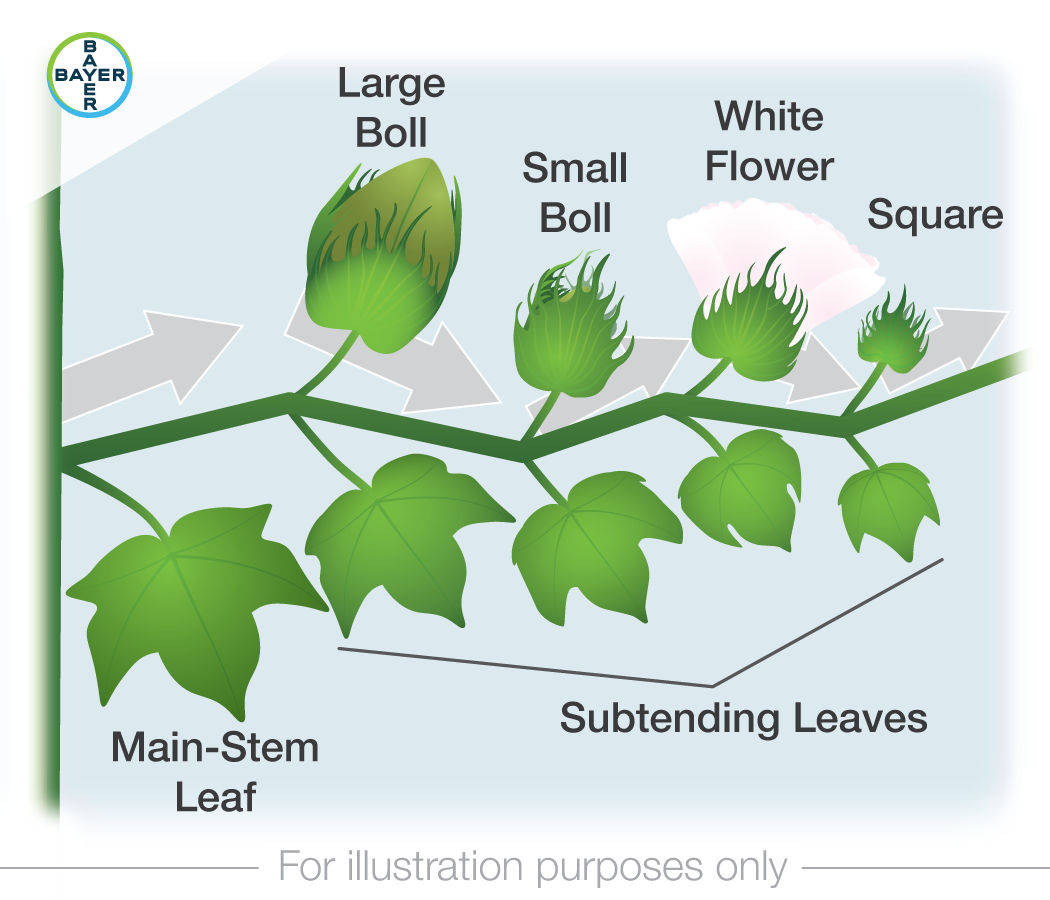
Cotton plants develop two types of branches: vegetative and fruiting.
Vegetative branches. Straight-growing branches intended for producing energy through photosynthesis. Mainstem and other vegetative branches typically form on lower nodes.
Fruiting branches. Branches that grow in a zigzag pattern, with multiple meristems that form fruiting buds. The first fruiting branch typically forms at mainstem node 5 or 6. New fruiting branches develop about every three days and squares form at new positions on fruiting branches every six days.
Reproductive Growth
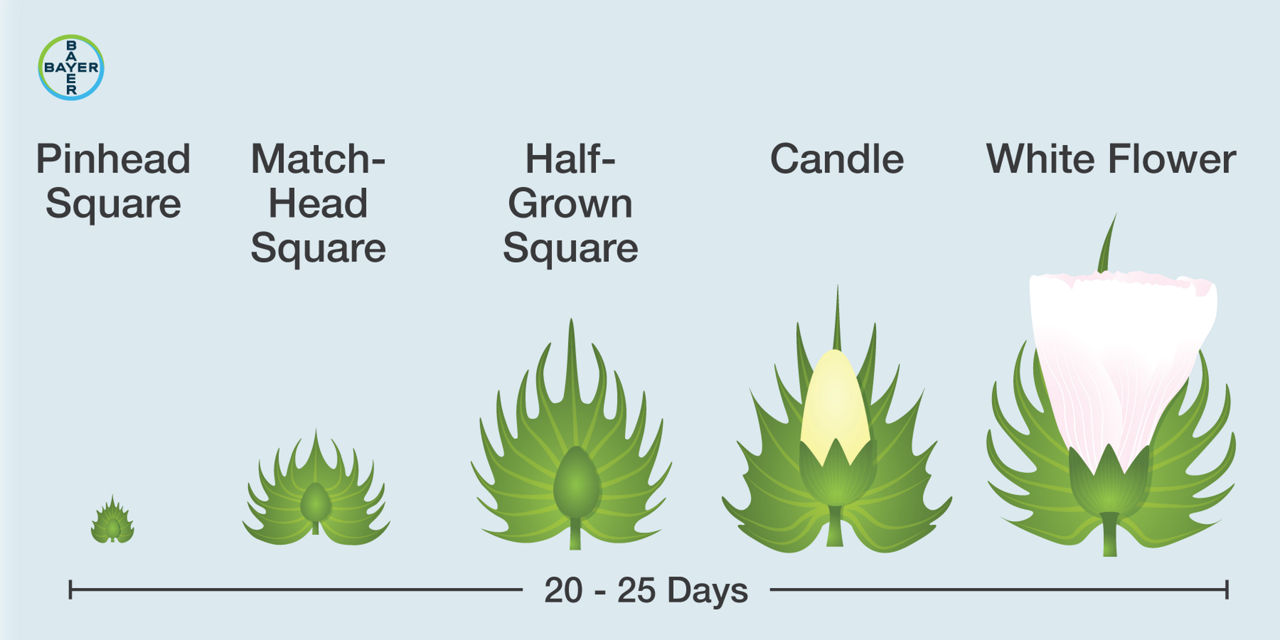
Reproductive growth is characterized by square development and node location on the plant.
Square development. The square (pre-bloom flower bud) forms when the fruiting branch forms.
First square position. This is the location where the first square is produced. As a square develops, the section of the branch between the main stem and square elongates, and an axillary meristem also develops on the branch adjacent to the square. The auxiliary meristem will produce a second position square and a subtending leaf. The first square typically forms on nodes 5 to 7.
Cotton bud formation. There are several development stages of a cotton bud (Figure 4). The white bloom stage occurs three to four weeks after the pinhead square stage.
Pinhead square. The first stage at which the square can be identified.
Match-head square. The bud is one third of its full size.
Candle. Occurs just prior to bloom. The bud is shaped like a candle.
White flower. Occurs once the bud blooms. The flowering period typically lasts four to six weeks and is characterized in terms of weeks of bloom. When a bloom first opens, the flower is white, and pollination may occur within hours of opening. By the next day, the flower has a pink tint, and turns dark pink the following day. Within the week, the flower dries up and falls off the plant, exposing a fertilized boll. During early bloom, the mainstem continues to grow and add new leaves, nodes, and squares. As more bolls are set, the plant’s energy is diverted from vegetative growth to boll formation.
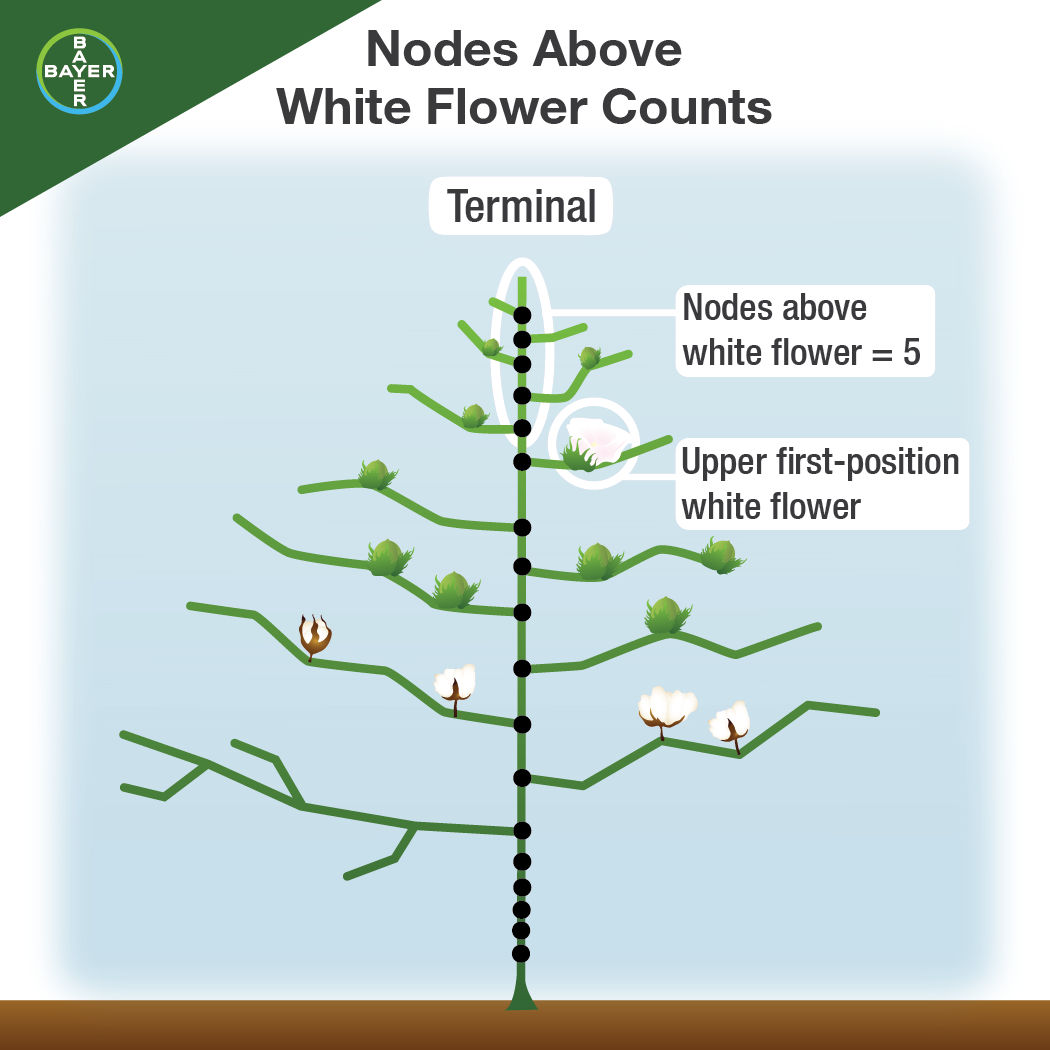
Nodes above white flower (NAWF). During flowering, cotton plant development may also be categorized in terms of NAWF. This measurement is taken by the number of nodes separating the uppermost first position bloom and the terminal of the plant. At first bloom, a plant may have 9 or 10 NAWF, and the number decreases as blooms continue to form up the plant. Flower development will eventually slow, and cutout occurs at around 4 or 5 NAWF, when no more harvestable bolls are set on the plant (Figure 5).
Boll Production
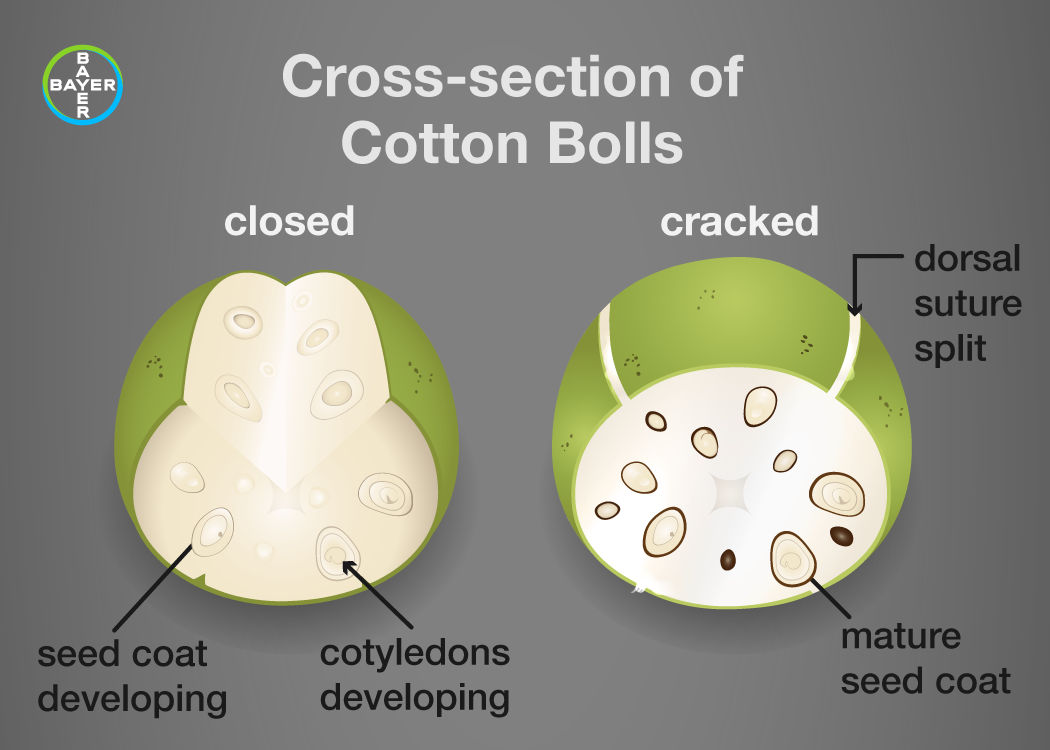
A boll can open in about 50 days with optimum growing conditions. Cotton fibers are very sensitive to environmental conditions during boll development. The three phases of boll development are as follows:
Enlargement. The fibers produced on the seed begin to elongate and the maximum volume of the boll and seeds are set. During this stage, the fibers during are a thin-walled tubular structure. This phase typically lasts three weeks.
Filling. The filling phase begins during the fourth week after flowering and will continue for two weeks. The secondary walls of the cotton fiber will form, a process known as deposition, and oil and proteins form in the seeds.
Maturation. This phase begins when the boll reaches full size and maximum weight. The fiber and seeds within the boll mature and boll dehiscence occurs. The walls of the boll dry and split, opening the boll.
Nutrient Demand
As a cotton plant grows, the demand for carbohydrates and nutrients increases. Earlier in the season, the plant sends all resources into vegetative and root growth. As the season progresses into reproductive growth, the plant prioritizes using resources for fruit production while continuing to support vegetative growth. Early cutout may occur if there are not enough nutrients to support both reproductive and vegetative growth. Plants may shed squares and small bolls to preserve larger bolls if the nutrient supply is low. This occurs more often after environmental stress—cloudy weather, high temperatures, moisture stress, or leaf damage during flowering. The reduced photosynthesis lowers carbohydrate production, resulting in square shed.4
Sources
1 Growth and development of a cotton plant. National Cotton Council and The Cotton Foundation. Advancing Cotton Education. https://www.cotton.org/tech/ace/growth-and-development.cfm/.
2 Ritchie, G.L., Bednarz, C.W., Jost, P.H., and Brown, S.M. 2007. Cotton growth and development. The University of Georgia Cooperative Extension Service. Bulletin 1252. https://esploro.libs.uga.edu/esploro/outputs/report/Cotton-growth-and-development/9949316286902959
3 Main, C. L. 2012. Cotton production in Tennessee. University of Tennessee Extension. W288. https://trace.tennessee.edu/utk_agexcrop/156/
4 Albers, D.W. 2023. Cotton plant development and plant mapping. Wilson, B. (Ed.) University of Missouri Extension. https://extension.missouri.edu/publications/g4268.
1414_229452
Seed Brands & Traits
Crop Protection
Disclaimers
- always read and follow pesticide label directions, insect resistance management requirements (where applicable), and grain marketing and all other stewardship practices. to review additional important information, click to open the menu below.expand_more
No dicamba may be used in-crop with seed with Roundup Ready® Xtend Technology, unless and until approved or specifically permitted, and no dicamba formulations are currently registered for such use in the 2024 season. Please follow www.roundupreadyxtend.com/xtendimaxupdates for status updates
Based on Court ruling and EPA Existing Stocks Order* on XtendiMax® Herbicide registration, Bayer has stopped its sale and distribution of XtendiMax® Herbicide. Visit our XtendiMax herbicide updates page to learn the latest www.roundupreadyxtend.com/xtendimaxupdates.
*Low-volatility dicamba products subject to the ruling include XtendiMax® herbicide with VaporGrip® Technology, Engenia® herbicide and Tavium® Plus VaporGrip® Technology herbicide.
The Preceon™ Smart Corn System, including short stature corn developed through traditional breeding, is expected to be available, subject to final commercialization decisions, for planting in the 2024 growing season.
Short stature corn developed through biotechnology is not currently available for commercial sale or commercial planting. Commercialization is dependent on multiple factors, including successful conclusion of the regulatory process.
This material may contain “forward-looking statements” based on current assumptions and forecasts made by Bayer management. Various known and unknown risks, uncertainties and other factors could lead to material differences between the actual future results, financial situation, development or performance of the company and the estimates given here. These factors include those discussed in Bayer’s public reports which are available on the Bayer website at www.bayer.com. The company assumes no liability whatsoever to update these forward-looking statements or to conform them to future events or developments.
*Commercialization is dependent on multiple factors, including successful conclusion of the regulatory process. The information presented herein is provided for educational purposes only, and is not and shall not be construed as an offer to sell, or a recommendation to use, any unregistered pesticide for any purpose whatsoever. It is a violation of federal law to promote or offer to sell an unregistered pesticide.
Bayer is a member of Excellence Through Stewardship® (ETS). Bayer products are commercialized in accordance with ETS Product Launch Stewardship Guidance, and in compliance with Bayer’s Policy for Commercialization of Biotechnology-Derived Plant Products in Commodity Crops. Commercialized products have been approved for import into key export markets with functioning regulatory systems. Any crop or material produced from this product can only be exported to, or used, processed or sold in countries where all necessary regulatory approvals have been granted. It is a violation of national and international law to move material containing biotech traits across boundaries into nations where import is not permitted. Growers should talk to their grain handler or product purchaser to confirm their buying position for this product. Excellence Through Stewardship® is a registered trademark of Excellence Through Stewardship.
XtendiMax® herbicide with VaporGrip® Technology has been classified as pesticide and must be used with VaporGrip® Xtra Agent (or an equivalent volatility reduction adjuvant). For approved tank-mix products (including VRAs and DRAs), nozzles and other important label information visit XtendiMaxApplicationRequirements.com. Applicators must check XtendiMaxApplicationRequirements.com no more than 7 days before application of this product for additional labeling, including state restrictions. Where applicable, users must comply with additional requirements found on this website.
ALWAYS READ AND FOLLOW PESTICIDE LABEL DIRECTIONS. Not all products are registered for use in all states and may be subject to use restrictions. The distribution, sale, or use of an unregistered pesticide is a violation of federal and/or state law and is strictly prohibited. Check with your local dealer or representative for the product registration status in your state.
Product Use Statement: Enlist E3® soybeans contain the Enlist E3 trait that provides crop safety for use of labeled over-the-top applications of glyphosate, glufosinate and 2,4-D herbicides featuring Colex-D® technology when applied according to label directions. Following burndown, the only 2,4-D containing herbicide products that may be used with Enlist® crops are products that feature Colex-D technology and are expressly labeled for use on Enlist crops. 2,4-D products that do not contain Colex-D technology are not authorized for use in conjunction with Enlist E3 soybeans. Warning: Enlist E3 soybeans are tolerant of over-the top applications of glyphosate, glufosinate, and 2,4-D. Accidental application of incompatible herbicides to this variety could result in total crop loss. When using 2,4-D herbicides, grower agrees to only use 2,4-D products that contain Colex-D technology authorized for use in conjunction with Enlist E3 soybeans. Always read and follow herbicide label directions prior to use.
YOU MUST SIGN A TECHNOLOGY AGREEMENT, READ THE PRODUCT USE GUIDE PRIOR TO PLANTING AND FOLLOW HERBICIDE RESISTANCE MANAGEMENT (HRM) REQUIREMENTS.
The transgenic soybean event in the Enlist E3® soybeans is jointly developed and owned by Corteva Agriscience and M.S. Technologies, L.L.C. ®™ Enlist, Enlist E3, the Enlist E3 logo and Colex-D are trademarks Corteva Agriscience and its affiliate companies.
Alloy™ and Connect™ are trademarks of M.S. Technologies, L.L.C., West Point, IA. Please read the M.S. Technologies, L.L.C. Use Restriction Agreement located at: - http://www.mstechseed.com/use-restriction-agreement/.
ALWAYS READ AND FOLLOW PESTICIDE LABEL DIRECTIONS. FOR COTTON TREATED FOR MARKET YEAR 2024, EACH ACCELERON® SEED APPLIED SOLUTIONS OFFERING is a combination of separate individually registered products containing the active ingredients: BASIC Offering: fluoxastrobin, prothioconazole, metalaxyl, myclobutanil, and penflufen. STANDARD Offering: fluoxastrobin, prothioconazole, metalaxyl, myclobutanil, penflufen, and imidacloprid. ELITE plus Copeo® Offering: fluoxastrobin, prothioconazole, metalaxyl, myclobutanil, penflufen, imidacloprid, and fluropyram.
FOR COTTON TREATED FOR MARKET YEAR 2022 OR PRIOR, EACH ACCELERON® SEED APPLIED SOLUTIONS OFFERING is a combination of separate individually registered products containing the active ingredients: BASIC Offering: fluxapyroxad, pyraclostrobin, metalaxyl, and myclobutanil. STANDARD Offering: fluxapyroxad, pyraclostrobin, metalaxyl, myclobutanil, and imidacloprid. ELITE plus Poncho®/VOTiVO® Offering: fluxapyroxad, pyraclostrobin, metalaxyl, myclobutanil, imidacloprid, clothianidin, and Bacillus Firmus I-1582.
Please review each seed tag to determine active ingredients in the product offering on the seed. The distribution, sale, or use of an unregistered pesticide is a violation of federal and/or state law and is strictly prohibited. Not all products are approved in all states.
ALWAYS READ AND FOLLOW PESTICIDE LABEL DIRECTIONS. FOR SOYBEANS SEED TREATMENT PRODUCTS APPLIED DOWNSTREAM, EACH ACCELERON® SEED APPLIED SOLUTIONS OFFERING is a combination of separate individually registered products containing the active ingredients: BASIC Offering: metalaxyl, penflufen and prothioconazole. STANDARD Offering: metalaxyl, penflufen, prothioconazol and imidacloprid. FOR UPSTREAM TREATED SOYBEANS, EACH ACCELERON® SEED APPLIED SOLUTIONS OFFERINGis a combination of separate individually registered products containing the active ingredients: BASIC Offering: metalaxyl, fluxapyroxad, and pyraclostrobin. STANDARD Offering: metalaxyl, fluxapyroxad, pyraclostrobin and imidacloprid. The distribution, sale, or use of an unregistered pesticide is a violation of federal and/or state law and is strictly prohibited. Not all products are approved in all states.
ALWAYS READ AND FOLLOW PESTICIDE LABEL DIRECTIONS. FOR CORN, EACH ACCELERON® SEED APPLIED SOLUTIONS OFFERING is a combination of separate individually registered products containing the active ingredients: BASIC plus Poncho®/VOTiVO® Offering for corn: metalaxyl, ethaboxam, prothioconazole, fluoxastrobin, clothianidin, Bacillus firmus I-1582. ELITE plus Poncho®/VOTiVO® Offering for corn: metalaxyl, ethaboxam, clothianidin, and Bacillus firmus I-1582; prothioconazole and fluoxastrobin at rates that suppress additional diseases. BASIC Offering for corn: metalaxyl, prothioconazole, fluoxastrobin, ethaboxam, and clothianidin. ELITE Offering for corn: metalaxyl, ethaboxam, and clothianidin; and prothioconazole and fluoxastrobin at rates that suppress additional diseases. BioRise® Corn Offering is included seamlessly across offerings on all class of 2017 and newer products. The distribution, sale, or use of an unregistered pesticide is a violation of federal and/or state law and is strictly prohibited. Not all products are approved in all states.
Performance may vary, from location to location and from year to year, as local growing, soil and weather conditions may vary. Growers should evaluate data from multiple locations and years whenever possible and should consider the impacts of these conditions on the grower’s fields.
The Bayer Carbon Program described in this material is subject to the current version of the Bayer Carbon-Smart Practices Master Agreement. The information is to aid in the understanding of the Bayer Carbon Program and does not change or modify the Bayer Carbon-Smart Practices Master Agreement in any way.
The RRXtend Spray App provides forecasts for locations within the contiguous United States. Do not use this app for forecasts outside the contiguous United States. Forecasts are for planning purposes only and are not a substitute for checking actual weather conditions at your location at the time of application and comply with the product label and other legal requirements.
B.t. products may not yet be registered in all states. Check with your seed brand representative for the registration status in your state.
Refuge seed may not always contain the DroughtGard® trait. Adament™ 50 WG Fungicide is only registered in California. Roundup Technology® includes glyphosate-based herbicide technologies.
IMPORTANT IRM INFORMATION: Certain products are sold as RIB Complete® corn blend products, and do not require the planting of a structured refuge except in the Cotton-Growing Area where corn earworm is a significant pest. Products sold without refuge in the bag (non-RIB Complete) require the planting of a structured refuge. See the IRM/Grower Guide for additional information. Always read and follow IRM requirements.
ONLY USE FORMULATIONS THAT ARE SPECIFICALLY LABELED FOR SUCH USES AND APPROVED FOR SUCH USE IN THE STATE OF APPLICATION. Contact the U.S. EPA and your state pesticide regulatory agency with any questions about the approval status of dicamba herbicide products for in-crop use with products with XtendFlex® Technology.
ALWAYS READ AND FOLLOW PESTICIDE LABEL DIRECTIONS. It is a violation of federal and state law to use any pesticide product other than in accordance with its labeling. NOT ALL formulations of dicamba or glyphosate are approved for in-crop use with Roundup Ready 2 Xtend® soybeans. NOT ALL formulations of dicamba, glyphosate or glufosinate are approved for in-crop use with products with XtendFlex® Technology.
Roundup Ready® Technology contains genes that confer tolerance to glyphosate. Roundup Ready® 2 Technology contains genes that confer tolerance to glyphosate. LibertyLink® Technology contains genes that confer tolerance to glufosinate. Roundup Ready® Flex Technology contains genes that confer tolerance to glyphosate. Roundup Ready technology contains genes that confer tolerance to glyphosate, an active ingredient in Roundup® brand agricultural herbicides. Roundup Ready 2 Xtend® soybeans contain genes that confer tolerance to glyphosate and dicamba. Products with XtendFlex® Technology contains genes that confer tolerance to glyphosate, glufosinate and dicamba. Plants that are not tolerant to glyphosate, dicamba, and/or glufosinate may be damaged or killed if exposed to those herbicides. Contact your seed brand dealer or refer to the Bayer Technology Use Guide for recommended weed control programs.
Insect control technology provided by Vip3A is utilized under license from Syngenta Crop Protection AG. Movento® MPC Insecticide is only registered for use in Florida, Georgia and Alabama. Aeris®, Balance® Flexx, Baythroid® XL, Corvus®, Degree Xtra®, Harness® Xtra 5.6L Herbicide, Harness® Xtra Herbicide, Huskie® Complete, Leverage® 360, and TriVolt™ are restricted use pesticides. Not all products are registered for use in all states and may be subject to use restrictions. The distribution, sale, or use of an unregistered pesticide is a violation of federal and/or state law and is strictly prohibited. Check with your local dealer or representative for the product registration status in your state. Fortenza Advanced™ is an on-seed application of Fortenza® and Rascendo® seed treatments. Agrisure Viptera®, Fortenza Advanced™, Fortenza® and Rascendo® are trademarks of Syngenta Group Company. Tank mixtures: The applicable labeling for each product must be in the possession of the user at the time of application. Follow applicable use instructions, including application rates, precautions and restrictions of each product used in the tank mixture. Not all tank mix product formulations have been tested for compatibility or performance other than specifically listed by brand name. Always predetermine the compatibility of tank mixtures by mixing small proportional quantities in advance. Degree® is a registered trademark of Monsanto Technology LLC. Channel®, Channel® and the Arrow Design® and Seedsmanship At Work® are registered trademarks of Channel Bio, LLC. Services and products offered by Climate LLC are subject to the customer agreeing to our Terms of Service. Our services provide estimates or recommendations based on models. These do not guarantee results. Consult with your agronomist, commodity broker, or other industry professional before making financial, farming, or risk management decisions. More information at www.climate.com/legal/disclaimer. FieldView™ is a trademark of Climate LLC. Herculex® is a registered trademark of Dow AgroSciences LLC. Clearfield®, Copeo®, ILeVO®, LibertyLink logo® , LibertyLink®, Poncho®, Poncho®/Votivo® and Votivo® are trademarks of BASF Corporation. Respect the Refuge and Corn Design® and Respect the Refuge® are registered trademarks of National Corn Growers Association. Some of the product(s) discussed herein are restricted use pesticide(s) and may not be registered in all states. The distribution, sale, or use of an unregistered pesticide is a violation of federal and/or state law and is strictly prohibited. Check with your local dealer or product representative for the product registration status in your state. Absolute®, Acceleron®, Adament™, Admire®, Aeris®, Aliette®, Alion®, Allegiance®, Asgrow and the A Design®, Asgrow®, Autumn™, Axiom®, Balance®, Bayer, Bayer Cross, Baythroid®, BioRise®, Bollgard II®, Bollgard®, BUTEO™ start, Capreno®, ConnectIN™, Corn States Triangle Design®, Corvus®, Degree Xtra®, DEKALB and Design®, DEKALB®, Delaro®, Deltapine Select™, Deltapine®, DiFlexx®, Disease Shield®, DroughtGard®, DryTough™, Emesto®, Evergol®, EverGol®, FarmFlex®, Finish®, Flint®, Fontanelle Hybrids and Design®, Fontanelle Hybrids®, Gaucho®, Gem®, Ginstar®, Gold Country Seed®, Ground Breakers®, H Hubner and Design™, Harness®, Hubner Seed & Design®, Hubner Seed Your Trustworthy Seed Resource & Design®, Hubner Seed™, Huskie®, Jung Seed Genetics & Design®, Jung Seed Genetics™, Kruger Seeds™, Laudis® , Leaf Triangle Design®, Leverage®, Lewis Hybrids and Design®, Lewis Hybrids™ , Lewis Premium Grains & Design®, Luna Experience®, Luna Privilege®, Luna Sensation®, Luna Tranquility®, Luna® Flex, Luna® Pro Fungicide, Luxxur®, MILK MAXX SILAGE RESEARCH and Design®, Minuet™, Movento®, Movento® HL, Nortron®, Oberon®, Olympus®, Poncho®, Preceon™, Proline®, Propulse®, Prosaro®, Prosper®, Provost®, Raxil®, REA Hybrids and Design™, Rea Hybrids™ , Respect the Refuge and Cotton Design®, RIB Complete and Design®, RIB Complete®, Ricestar®, Rimfire®, Roundup PowerMAX®, Roundup Ready 2 Technology and Design®, Roundup Ready 2 Xtend®, Roundup Ready 2 Yield®, Roundup Ready®, Roundup Technology®, Roundup WeatherMAX and Design®, Roundup WeatherMAX®, Roundup®, RT 3 Powered by Roundup Technology and Design®, RT 3®, Scala®, Serenade®, Serenade® SOIL fungicide, SilageSmart & Design®, SilageSmart®, Sivanto®, SmartStax®, Specialty and Design®, Specialty Hybrids™, SR and Design®, Stance®, Stewart and Design™, Stewart Seeds™, Stone Seed & Design™, Stone Seed™, Stratego®, ThryvOn™, Trecepta®, Trilex®, TripleFLEX®, TriVolt™, TruFlex™, VaporGrip®, Varro®, Velum®, Vistive®, VT Double PRO®, VT Triple PRO®, VT4PRO™, VT4PRO™ , Warrant®, WestBred and Design®, WestBred®, Wolverine®, XtendFlex®, XtendiMax® and YieldGard VT PRO® are trademarks of Bayer Group. All other trademarks are the property of their respective owners. For additional product information call toll-free 1-866-99-BAYER (1-866-992-2937) or visit our website at www.BayerCropScience.us. Bayer CropScience LP, 800 North Lindbergh Boulevard, St. Louis, MO 63167. ©2024 Bayer Group. All rights reserved.







©2024 Bayer Group. All rights reserved.